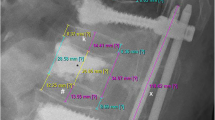Abstract.
The authors present a retrospective clinical and radiological study addressing the outcome after posterior stabilisation of thoracolumbar fractures with intervertebral fusion via transpedicular bone grafting. The study included computed tomographic (CT) scan after implant removal for analysis of the intervertebral fusion and incorporation of the intervertebral bone graft and its influence on postoperative re-kyphosing. Twenty-nine patients with acute fractures of the thoracolumbar spine, treated between 1988 and 1995 at the Department of Trauma Surgery, Hannover Medical School, underwent posterior stabilisation and interbody fusion with transpedicular cancellous bone grafting. This study group was followed clinically and radiologically for a mean of 3.5 years. All patients underwent spiral CT scan with sagittal reconstruction after implant removal. Twenty-four type A, four type B, and one type C lesion were posteriorly stabilised and transpedicular intervertebral bone grafting was performed. The operative time averaged 2 h 50 min, the intraoperative fluoroscopy time 4 min 7 s, and the mean intraoperative blood loss was 376 ml. Four patients out of six with an incomplete neurologic lesion (Frankel/ASIA D) improved to Frankel/ASIA grade E. Two complications were observed: one delayed wound healing and one venous thrombosis with secondary pulmonary embolism. Compared to the preoperative status, our follow-up examinations demonstrated permanent social sequelae: the percentage of individuals able to do physical labor was reduced, whereas the proportion of unemployed or retired patients increased. The assessment of complaints and functional outcome with the Hannover Spine Score reflected a significant difference (P<0.001) between the status before injury (96.6/100 points) and at follow-up (64.4/100 points). The radiographic follow-up revealed a mean loss of correction of 7.8° (P<0.005). CT scans after implant removal showed an interbody fusion and incorporation of the transpedicular bone graft in ten patients (34%). In another ten patients (34%), the CT scans demonstrated the interbody fusion at the anterior and posterior walls of the vertebral body via direct contact due to collapse of the disc space. In these patients, the bone graft was not incorporated and no central interbody fusion could be found. In nine patients (31%) neither interbody fusion nor incorporation of the transpedicular graft was achieved. A frequent and reliable intervertebral fusion could not be achieved with the described technique of transpedicular bone grafting. The ineffectiveness of the intervertebral graft was found to be a reason for postoperative re-kyphosing.
Similar content being viewed by others
Author information
Authors and Affiliations
Additional information
Electronic Publication
Rights and permissions
About this article
Cite this article
Knop, C., Fabian, H., Bastian, L. et al. Fate of the transpedicular intervertebral bone graft after posterior stabilisation of thoracolumbar fractures. Eur Spine J 11, 251–257 (2002). https://doi.org/10.1007/s00586-001-0360-z
Received:
Revised:
Accepted:
Published:
Issue Date:
DOI: https://doi.org/10.1007/s00586-001-0360-z




